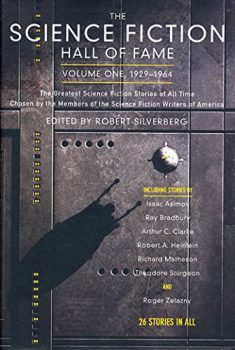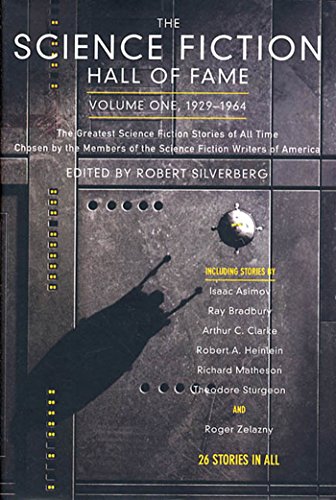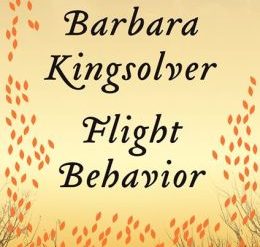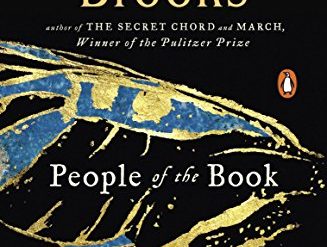
Science fiction fans speak of the Golden Age of Science Fiction, a period that, most broadly construed, ran from 1929 to 1964. SF Grand Master Robert Silverberg, acting on behalf of the Science Fiction Writers of America, included twenty-six stories published during that period in The Science Fiction Hall of Fame. It’s a motley collection that serves only to dramatize the fact that much of the work published in the genre in its early years was of questionable worth. However, the book does include several outstanding stories.
Unsurprisingly, the tales in this collection explore a wide range of themes. However, two stand out clearly, and they show their age. Many of the authors of these stories were preoccupied with nuclear energy. In stories published before 1945, a number of them wrote about rocket-powered spaceships, automobiles, and even personal flying devices. After that milestone, some wrote about nuclear fallout and nuclear war. And a number of the tales included here are about Martians—yes, walking, talking, humanoid (even human) Martians, who take walks with their human contacts in Mars’ punishingly cold, unbreatheable atmosphere. Was it really so recently that our understanding of the red planet was so limited?
The Science Fiction Hall of Fame, Volume One 1929-1964 edited by Robert Silverberg (1970) 579 pages ★★★☆☆
Few of the writers are familiar to fans today
- A handful of the writers featured in this collection are well known to science fiction fans today; Ray Bradbury, Arthur C. Clarke, Robert E. Heinlein, and, of course, Isaac Asimov.
- Others, probably little remembered now, lodge in my memory from my voracious reading of science fiction as a youngster: Anthony Boucher, Lewis Padgett, James Blish, John W. Campbell, Theodore Sturgeon, C. M. Kornbluth, Murray Leinster, Richard Matheson, Alfred Bester, Damon Knight, Lester Del Rey, Clifford D. Simak, Cordwainer Smith, Fritz Leiber, A. E. Van Vogt, and Roger Zelazny.
- Still others were unfamiliar to me: Daniel Keyes (even though I clearly recalled his story), Judith Merril, Frederic Brown, Jerome Bixby, Tom Godwin, and Stanley G. Weinbaum.
Here, then, is a blow-by-blow account of the twenty-six short stories and novelettes in this anthology. I’ve arranged them in the order of the individual ratings I assigned them.
As you’ll see, there are just four outstanding stories (rated @@@@@) among the twenty-six selected by editor Robert Silverberg from among the dozens nominated by the members of the Science Fiction Writers of America. By contrast, seven are, in my estimation, clunkers (@ or @@).
If you’re getting the impression that I’m far more impressed with some of the authors writing in the field today, you are, of course, entirely right. I could easily name a dozen contemporary writers much of whose work stacks up against the very best of the stories included in this book. But all you have to do is read the novels of Becky Chambers, Mary Robinette Kowal, or Paolo Bacigalupi, and you’ll see what I mean.
The best of the lot in the Science Fiction Hall of Fame
★★★★★ Flowers for Algernon by Daniel Keyes (1959)
This unsettling story strikes me as the best of the lot. Because Charlie is a mentally disadvantaged young man who eagerly wants to learn, his teacher recommends him as a subject to a neurosurgeon and a psychologist who have devised a way to increase a person’s intelligence through surgery. We follow Charlie’s experience with the experiment from his hapless days as the butt of jokes among the men he works with as a janitor through his growing awareness of the world around him as the impact of the surgery becomes ever more pronounced.
★★★★★ Mimsy Were the Borogoves by Lewis Padgett (1943)
Padgett was the pen name for the husband-and-wife team of Henry Kuttner and C. L. Moore. This is a delightful tale of two young children who come across a box of educational toys from thousands of years in the future.
★★★★★ The Quest for Saint Aquin by Anthony Boucher (1951)
Far in the future, some time following a devastating nuclear war, life goes on under the tyrannical Technarchy—science run amok. In this brave new world, Christians are persecuted to the death, but an envoy of the beleaguered Pope bravely sets out on a dangerous quest in the company of a robot to find the legendary Aquin. His mission: to determine whether Aquin is worthy of sainthood.
★★★★★ Surface Tension by James Blish (1952)
One of several hundred human “seed-ships” dispatched across the galaxy has crashed on the sole continent of the water-planet Hydrot. The crew, all destined to die, spend their remaining time engineering a microscopic new human species that will live underwater. This tale explores the lives of the new species as it comes to terms with its human heritage on an inhospitable world.
Also worthy of inclusion in the Science Fiction Hall of Fame
★★★★☆ Twilight by John W. Campbell (1934)
An inventive look at humanity in the far, far future by the man who later masterminded the Golden Age of Science Fiction as the editor of the magazine Astounding Science Fiction. Routinely included among the best examples of classic science fiction.
★★★★☆ Microcosmic God by Theodore Sturgeon (1941)
A charming story about an inventor and the greedy banker who tries to control him.
★★★★☆ Mars Is Heaven! by Ray Bradbury (1948)
On a mission to Mars, the crew of an American spaceship land in what seems to be a typical small Midwestern town, circa 1927. Is it proof of an earlier landing on the Red Planet? Or of something more sinister?
★★★★☆ The Little Black Bag by C. M. Kornbluth (1950)
A practical joker in a far-future Earth sends a doctor’s bag in a time machine back to mid-twentieth century America, where it is recovered by an old drunk, a doctor whose license was lifted years earlier for medical fraud.
★★★★☆ The Nine Billion Names of God by Arthur C. Clarke (1953)
The lamas at a Tibetan lamasery acquire a mainframe computer and hire two engineers to service it for the three months it will be needed. Their charge: to compile and print the nine billion names of God, as calculated by the lamas. Once the names are all printed, they predict, the world will come to an end.
Fair-to-middling stories in the Science Fiction Hall of Fame
★★★☆☆ Nightfall by Isaac Asimov (1941)
One of many stories John W. Campbell suggested to the young Asimov, this account of life on a planet with six suns and the threat of a total eclipse reads as just silly today, although Campbell’s premise is interesting.
★★★☆☆ First Contact by Murray Leinster (1945)
This 1945 novelette put the phrase First Contact into the lexicon of science fiction. It’s a simple tale of an encounter 4,000 light-years from Earth between the crew of a human spaceship and that of one from an alien species. Like so many of these stories from the Golden Age of Science Fiction, it comes across as both naive and unrealistic.
★★★☆☆ That Only a Mother by Judith Merril (1948)
Published shortly after World War II, this short story reflected the widespread hysteria about birth defects from “atomic radiation,” as the world woke up to the aftermath of Hiroshima and Nagasaki. Radiation poisoning and birth defects were a reality, of course, and tragically intensive in and near the two Japanese cities, but far less common elsewhere than many then believed.
★★★☆☆ Arena by Fredric Brown (1944)
Are you familiar with the concept of deus ex machina? Brown brings this idea to the fore when the human race faces off with a hostile alien species in interstellar battle.
★★★☆☆ Born of Man and Woman by Richard Matheson (1950)
This story appears to have come from the same place as Judith Merrill’s piece on birth defects caused by nuclear radiation, although that’s not explicitly stated. And, to my mind, this tale qualifies more as horror than as science fiction. I don’t think it belongs in this collection.
★★★☆☆ It’s a Good Life by Jerome Bixby (1953)
If Stephen King had been writing in 1953—he was six years old then—he might have crafted this story about the young son of a rural couple who terrorizes everyone in their village through the power of his mind. The story works, but like the Matheson tale it’s better described as horror than as science fiction. And, just to be clear, I am not a fan of horror stories.
★★★☆☆ The Cold Equations by Tom Godwin (1954)
During the Golden Age of Science Fiction, magazine editors paid for stories by the word—a penny, two cents, or far more for a well established author. The best writers (and editors) hid the inevitable repetition. Some didn’t, and here’s a sad example. “The Cold Equations” is a less than gripping tale of a teenage girl who stows away on an interstellar ship, ignorant of the consequences. Spoiler alert: this is a tearjerker.
★★★☆☆ Fondly Fahrenheit by Alfred Bester (1954)
Here’s a creepy story about a murderous android and his owner, with a focus on the relationship between them. (BTW, I would have enjoyed this book more if I had read it rather than listened to it as an audio recording. I find that I miss important clues when I simply hear them.)
★★★☆☆ The Country of the Kind by Damon Knight (1955)
Damon Knight was a gifted writer. His prose sings. But this story, like much of his work, is better categorized as fantasy rather than science fiction. I don’t read fantasy.
★★★☆☆ A Rose for Ecclesiastes by Roger Zelazny (1963)
Although this story is remarkably well written, I found it to be tedious. It’s a contrived tale of a poet from Earth who is part of a mission to Mars who falls in love with a Martian woman—yes, a Martian woman. The poet is the son of a Bible-thumping preacher and is himself obsessed with religion. Guess what? So are the Martians. How’s that for an exercise in projection?
These stories don’t belong in the Science Fiction Hall of Fame
★★☆☆☆ Helen O’Loy by Lester del Rey (1938)
A sexist and silly story about two men and a robotic woman that’s not worth the time to read it.
★★☆☆☆ The Roads Must Roll by Robert A. Heinlein (1940)
A Right-Wing, anti-union diatribe about a future USA in which automated roads have replaced vehicle traffic. All too typical of the highly overrated author.
★★☆☆☆ Huddling Place by Clifford D. Simak (1944)
Speculating that in the future humankind will retreat from the cities—and eventually from space exploration—as we fall victim to an epidemic of agoraphobia. Silly, no?
★★☆☆☆ Scanners Live in Vain by Cordwainer Smith (1948)
This is a novelette about “scanners” and “Habermans.” They’re people, and both are somehow involved in space travel, but I couldn’t figure out what either of them actually does, or why. I couldn’t finish this confusing and poorly written tale.
★★☆☆☆ Coming Attraction by Fritz Leiber (1950)
Fritz Leiber seems to be predicting that in some future society women will freely bare their breasts but veil their faces. I’m not sure where this idea comes from, but it’s lame as well as sexist.
★☆☆☆☆ A Martian Odyssey by Stanley G. Weinbaum (1934)
A fanciful account of an expedition on Mars that’s little more insightful than anything written about the Red Planet in the nineteenth century.
★☆☆☆☆ The Weapon Shop by A. E. van Vogt (1942)
Don’t bother. I couldn’t get through it.
For further reading
Check out my review of Astounding: John W. Campbell, Isaac Asimov, Robert A. Heinlein, L. Ron Hubbard, and the Golden Age of Science Fiction by Alec Nevala-Lee (Isaac Asimov, Robert A. Heinlein, and the man who made their careers).
I’ve also reviewed The Collected Stories of Arthur C. Clarke, Audible Edition, narrated by Ralph Lister, Ray Porter, and Jonathan Davis (The SF stories of Arthur C. Clarke aren’t great). One of those stories is in the Hall of Fame collection.
For more good reading, check out:
- The ultimate guide to the all-time best science fiction novels;
- Great sci-fi novels reviewed: my top 10 (plus dozens of runners-up); and
- The top 10 dystopian novels reviewed here (plus dozens of others).
And you can always find my most popular reviews, and the most recent ones, plus a guide to this whole site, on the Home Page.


























